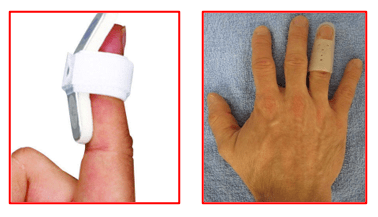Mallet Finger
A mallet finger is a deformity of the finger wherein the finger remains in a bent (flexed) position and it is not possible to straighten it.
This injury happens when the fingertip gets forcibly bent leading to damage to the extensor tendon which normally straightens the finger. A ball or any object that strikes the fingertip causes it to bend forcefully leading to this injury.
In some patients the tendon may not be damaged, but it pulls away with a piece of bony. This is an avulsion fracture of base of distal phalanx that also leads to a mallet deformity of the finger.

The diagnosis of mallet finger is made based on patient’s history of injury, clinical examination and x-rays of the affected finger.
Patient’s finger is swollen, painful and bruised. It remains in a bent or drooped position at the tip. Patients are unable to straighten their fingertip on their own.
The finger is tender on pressure and fingertip movements are painfully limited. Bending of fingertip is possible but straightening is not. Occasionally, blood collects beneath the nail. The nail can even become detached from beneath the skin fold at the base of the nail.
X-rays of the finger may show an avulsion fracture of the base of distal phalanx. It also helps to see if the fingertip (DIP) joint is still well aligned or not.
Mallet finger can be treated conservatively or surgically. Conservative treatment is effective and most commonly used.
- Ice packs to finger is done 4 to 5 times a day. Hand is kept elevated.
- Painkiller medications are taken as needed.
- Various types of Mallet finger splints can be used to keep the fingertip joint in full extension for 8 weeks to allow healing of the tendon or avulsion fracture. The tapping for the splint is changed frequently to avoid skin problems. Mallet splints only support the fingertip joint. They allow other joints of the finger to be mobilised. In order to avoid finger stiffness, finger exercises are actively encouraged with the splint on.

- With splinting, the injury heals up leading to reasonable and cosmetic appearance of the finger. But some patients make still have a mild finger extension lag. Hence additional 4 to 6 weeks of night splinting may be advised along with finger exercises.
- Patients with avulsion fracture of the fingertip extensor tendons are advised finger x-rays at 1 week, 2 weeks and 6 weeks mark to ensure proper alignment of fracture fragments & the DIP joint, and to assess bony healing of the fracture.
- In children, mallet finger injuries may involve the cartilage that controls bone growth. Surgeons carefully evaluate and treat such injuries in children, so that the finger does not become stunted or deformed.
- It is especially important to seek immediate attention if there is blood beneath the nail or if the nail is detached. This may be a sign of a nail bed laceration or an open (compound) fracture.
- mallet finger injuries have large bone fragments, or the DIP joint is malalignment.
- there is nail avulsion, nail bed laceration or an open (compound) fracture
- conservative treatment fails to restore adequate finger extension.
- overstretched extensor tendon needs tightening to correct the deformity
- fingertip (DIP) joint needs fusion.

Post-surgery splinting and protection of the finger remains same as with conservative treatment. If wires are used, then they are removed at 8 weeks mark, after x-rays confirm fracture healing.
The risks and complications associated with mallet finger surgery are:
- Infection
- Swelling
- Stiffness
- Joint incongruency
- Arthritis
- Skin ulceration and maceration due to splints
- Nail deformity
- Persistent extension lag at fingertip
- Re-surgery if fracture fixation fails or any complication arises before fracture healing
Book An Appointment
Private Clinics : Locations & Directions
London Joints Clinic (Pune)
Address
Office S 5, 2nd Floor, North Block, Sacred World Mall,
Opp Sacred Heart Township, Near Jagtap Chowk,
Wanawadi, Pune 411040
Monday, Wednesday & Friday 7 PM to 9 PM
Sunday 11 AM to 1 PM
Appointments
London Joints Clinic ( PCMC )
Address
C/O Dr Nitin’s Physio Clinic,
Opp. Brahma Hotel,
Near Akurdi Post Office,
Vivek Nagar,
Akurdi,
Pune 411035
Saturdays only 4.30 PM to 7.30 PM
Appointments
Hospitals OPDs : Locations & Directions
Manipal Hospital

Address
Manipal Hospital, Opp D Mart, Baner-Mhalunge Road, Baner, Pune 411 045
Monday to Saturday 11 AM to 4 PM
Appointments
Contact us
Dr Anand Jadhav has a centralised appointment system for all locations across various hospitals and clinics in Pune & PCMC areas
Appointment Bookings & Requests can be made by any method :

